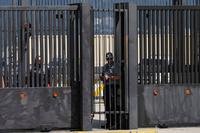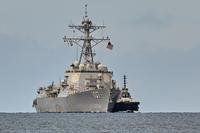When the USS Jimmy Carter sailed into its home port in Washington state in September 2017, it was flying an unusual flag: the distinctive skull and crossbones of a Jolly Roger.
There’s no telling exactly what the Jimmy Carter was doing at sea, as its missions are probably among the most closely guarded secrets in the U.S. Navy, but submarines fly those pirate flags when they return from a mission after some kind of “operational action.”
While no one outside of the crew can tell you what that “operational action” entailed, the history of Western submarines flying the Jolly Roger upon a successful return is a funny bit of history.
Submarines haven’t always been an accepted part of naval warfare. When they first became a viable technology, some old sailors thought they were a less-than-gentlemanly act of war. They compared the idea of silently striking the enemy from under the waves to an act of piracy.
Whether the old salts liked it or not, submarines were here to stay. And as if to prove you can’t just call sailors anything you happen to find derogatory, those early submariners adopted the pirate theme and made it their own.
Sir Arthur Wilson was the first sea lord of England’s Royal Navy when submarines entered active service. He was a great naval officer and Victoria Cross recipient while at sea. But by land, even as first sea lord, Wilson wasn’t impressing anyone. He’s mostly remembered for a short tenure, marked mostly by being a loud crank.
No matter how cranky Wilson was, he was still in charge. If he thought submarines were a dirty way of fighting, one would think he’d ax the program. Instead, he did the opposite, actually promoting the use of submarines as a future for the Royal Navy.
Being the first sea lord that no one seemed to like might have been the reason he gets credited for saying submarines were “underhanded, unfair and damned un-English.” There’s no actual proof he said this, but history isn’t kind to unlikable people.
What Wilson did say about submarines came long before he was the one making the decisions for the navy, because it also flies in the face of what he actually did as first sea lord:
“They’ll never be any use in war, and I’ll tell you why. I’m going to get the First Lord to announce that we intend to treat all submarines as pirate vessels in wartime and that we’ll hang all the crews.”
When World War I broke out in 1914, the Royal Navy’s submarines got its first taste of naval combat. A contemporary of Wilson’s, Lt. Cmdr. Max Horton was out to sea aboard one of England’s earliest submarines, the HMS E9. Horton and the E9 were off the coast of German islands in the North Sea when they came upon the German light cruiser Hela.
Horton torpedoes Hela from 600 yards, and the cruiser was soon at the bottom of the sea. The E9 evaded German anti-submarine efforts for the entire voyage back to safer waters, but once it arrived back in port, Horton hoisted a large Jolly Roger flag, a nod to Wilson’s threat of hanging his triumphant crew.
For every subsequent enemy he sunk, Horton intended to raise another pirate flag, but he ran out of room. Instead, he increased the size of his boat’s Jolly Roger and started adding symbols and other information to denote the submarine’s victories, similar to how airmen marked their kills on the nose of an aircraft.
Thus, a new tradition for submarines was born. By World War II, the practice not only grew, but pirate flags actually were issued to submarine crews. Submariners from Allied nations also joined in on the practice and have flown their Jolly Rogers ever since.

While some of the markings on these pirate flags are self-explanatory, others will be known only to the crew. When the Jimmy Carter returned to its Washington port flying one, there was a symbol on the flag -- but good luck finding out what that means.
-- Blake Stilwell can be reached at blake.stilwell@military.com. He can also be found on Twitter @blakestilwell or on Facebook.
Want to Learn More About Military Life?
Whether you're thinking of joining the military, looking for post-military careers or keeping up with military life and benefits, Military.com has you covered. Subscribe to Military.com to have military news, updates and resources delivered directly to your inbox.














